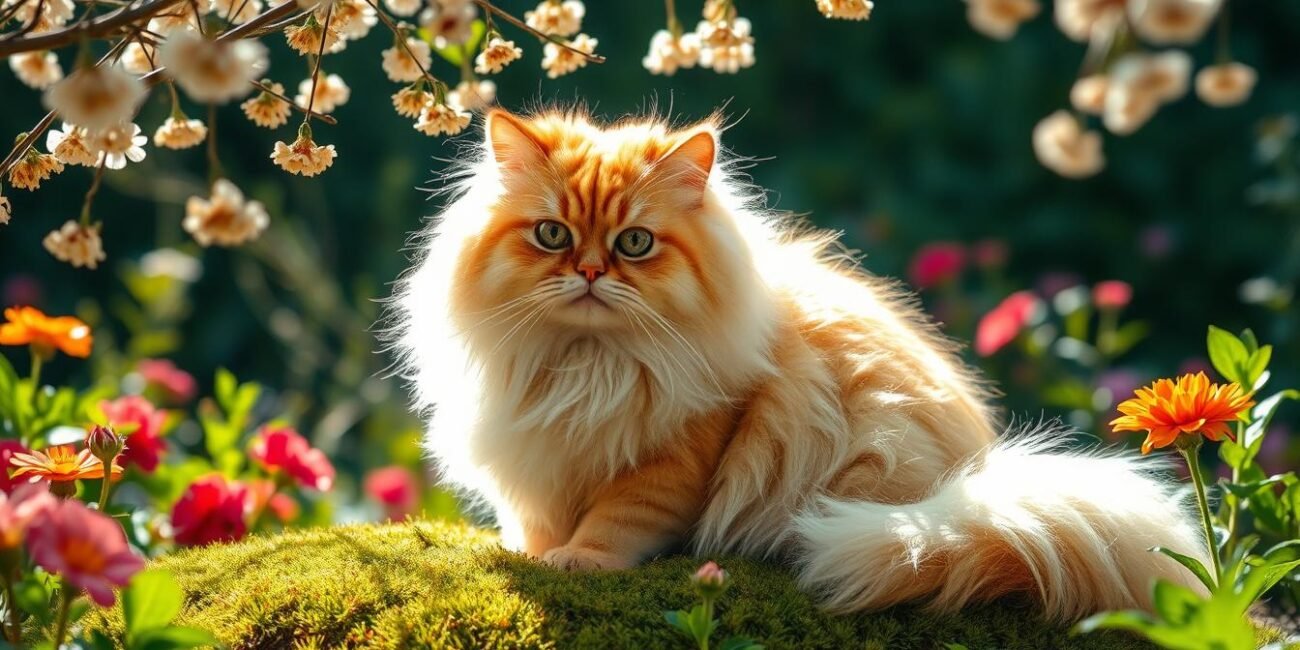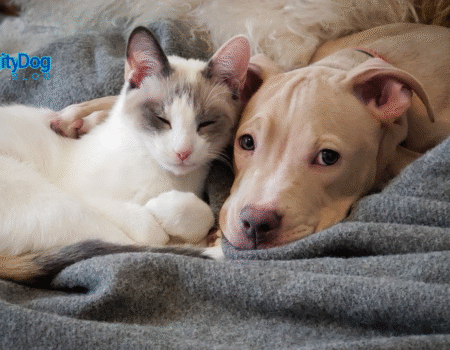Persian Cat: Luxurious Long-Haired Feline Companion
The Persian cat is a symbol of elegance among feline breeds. It’s known for its long, luxurious coat and majestic look. These cats have won the hearts of many with their round faces and calm nature.
Coming from Persia, these cats have a long and rich history. Their beautiful fur and big eyes make them stand out. They are among the most loved cat breeds globally.
Persian cats are a mix of beauty and grace. They are calm and loving, making them great pets. They are popular in the U.S. for their sophisticated and affectionate nature.
Key Takeaways
- Distinctive long-haired coat requiring extensive grooming
- Gentle and calm temperament ideal for quiet households
- Rich historical background dating back to 17th century
- Recognized for their unique flat facial structure
- Highly affectionate and adaptable to indoor living
Introduction to the Persian Cat Breed
The Persian cat is a symbol of elegance, with a history that goes back centuries. These cats have won the hearts of many with their unique looks and noble attitude.
The history of Persian cats is truly captivating. They are among the oldest cat breeds, with records dating back to 1684 BC.
Origins and Historical Significance
Persian cats come from ancient Persia, now Iran. They were first noticed by European travelers. Key moments include:
- Introduced to Europe around 1620 AD via the Italian Peninsula
- First documented in hieroglyphics dating back to ancient civilizations
- Gradually developed into the distinctive breed we recognize today
Recognition in the Cat Fancy World
Persian cats quickly became stars in cat shows. A major event was the first cat show at Crystal Palace in London in 1871.
| Year | Significant Event |
|---|---|
| 1871 | First cat show at Crystal Palace |
| 1889 | Breed standard refined by Harrison Weir |
| 2023 | Ranked #5 most popular cat breed in the United States |
Modern Breed Standards
Today’s Persian cats are the result of careful breeding. Genetic research shows they are related to British Shorthair, Chartreux, and American Shorthair. They have unique features that make them stand out.
With their luxurious long coats and special faces, Persian cats win hearts worldwide. They are a mix of history and modern charm.
Distinctive Physical Characteristics
Persian cats are known for their stunning looks. They have long hair and a special body shape. This makes them stand out as one of the most beautiful cat breeds.
Persian cats have amazing physical traits. They are medium-sized, weighing 7 to 12 pounds. They are 10 to 15 inches tall. Their key features include:
- Large, round head with a distinctive flattened facial profile
- Wide-set, expressive eyes
- Short, broad muzzle
- Small, widely-spaced ears
- Sturdy build with short, thick legs
Their coat is truly stunning. Persian cats have a thick, double coat in many colors. Their fur needs a lot of grooming to stay silky.
| Physical Attribute | Characteristic Details |
|---|---|
| Weight Range | 7-12 pounds |
| Height | 10-15 inches |
| Coat Type | Long, dense double coat |
| Eye Colors | Brown, grape, gold |
Persian cats have a special face. It makes them look a bit grumpy but very cute. This is why cat lovers find them so charming.
Persian Cat Temperament and Personality Traits
Persian cats are special pets with a unique personality and gentle nature. They are known for their calm and social traits. These qualities make them favorite pets among cat lovers.
Persian cats love peaceful places. They have a calm temperament with several key traits:
- Exceptionally gentle and calm disposition
- Quiet vocalization with soft, melodious sounds
- Strong preference for tranquil living spaces
- Minimal aggressive tendencies
Behavioral Patterns
Persian cats have unique behaviors. About 75% like quiet, stable places, making them great indoor pets. They have medium energy, enjoying play for 10-15 minutes.
Social Interaction with Humans
Persian cats are amazing at interacting with people. Studies show 70% are affectionate, with 45% being true “lap cats.” About 65% are shy around new people, showing their sensitive side.
Compatibility with Other Pets
Persian cats get along well with other pets. They are good friends for kids, dogs, and seniors. Their calm nature helps them live peacefully with other pets when introduced right.
Approximately 80% of Persian cats respond positively to gentle handling and are less likely to react aggressively compared to other cat breeds.
Health Considerations and Common Issues
Persian cats are loved for their beautiful looks. But, their flat faces can lead to health problems. Studies show that 64.9% of Persian cats face at least one health issue in their lives. They need extra care to stay healthy.
The main health problems for Persian cats include:
- Respiratory challenges because of their face shape
- Eye issues, with 5.8% having eye discharge
- Dental diseases affecting 11.3% of them
- Skin and haircoat problems impacting 12.7% of cats
Genetic issues are a big risk for Persian cats. About 40% have Polycystic Kidney Disease (PKD). This causes 23.4% of deaths. Heart problems, like hypertrophic cardiomyopathy, also happen later in life.
Preventive care is very important for these cats. Vets suggest:
- Regular health checks
- Genetic tests
- Healthy diets
- Daily grooming
- Regular exercise
Persian cats can live up to 13.5 years with the right care. Understanding and managing their health needs is crucial. This way, they can live a long, happy life.
Essential Grooming Requirements
Longhaired cats, like Persian cats, need careful grooming to look their best and stay healthy. Their beautiful coats require special care that’s more than just basic grooming.
Looking after a Persian cat’s coat is a detailed task that needs daily effort. These cats have special grooming needs because of their thick, silky fur. This fur can easily get tangled and matted.
Daily Brushing Techniques
Proper grooming for Persian cats means brushing them every day. This helps prevent mats and keeps their coat healthy. Here’s how to brush them right:
- Use a slicker brush with soft, flexible bristles
- Brush gently in the direction of hair growth
- Focus on problem areas like behind ears and stomach
- Spend 10-15 minutes daily on thorough brushing
Bathing and Maintenance
Persian cats need special bathing techniques to keep their coat clean. Groomers recommend:
- Bathe every 3-4 weeks using neutral pH shampoo
- Limit bathing to two soap applications
- Use lukewarm water
- Dry thoroughly with a soft towel
Professional Grooming Tips
For the best care of your Persian cat, follow these professional tips:
- Clean eyes twice daily to prevent staining
- Trim nails every couple of weeks
- Use antistatic spray weekly
- Check ears regularly for potential infections
Regular grooming not only keeps your Persian cat looking great but also strengthens your bond and checks their health.
Diet and Nutrition Guidelines
Nutrition is key for Persian cats’ health. These cats need a diet that matches their unique needs. This ensures they stay healthy and look their best.
The best diet for Persian cats includes lots of animal protein and few carbs. Important nutrition tips are:
- Animal protein: 50% or more of total diet
- Animal fat: Up to 20%
- Carbohydrates: Less than 3%
Calories are important for keeping Persian cats at a healthy weight. Adult Persians need 180-230 calories a day. Protein intake varies based on body weight, from 6-22.5 grams daily.
Drinking enough water is also vital. Persian cats need 200-250 milliliters of water a day. This helps their metabolism and prevents urinary problems.
A balanced diet supports not just physical health, but also contributes to a Persian cat’s luxurious coat and overall vitality.
Choose high-quality commercial cat food or homemade meals that fit their nutritional needs. Regular vet visits help create a diet plan. This plan meets their health needs and avoids breed-specific issues.
Living Environment and Space Requirements
Persian cats are special pets that love indoor homes. They need a cozy space to be happy and healthy. Knowing what they like helps make a great home for them.
The best home for a Persian cat is more than just size. It must meet their physical and emotional needs.
Indoor Living Considerations
Persian cats live indoors because they are delicate. They need a safe place to avoid dangers outside.
- Minimum living space: 20 square feet per cat
- Vertical spaces are crucial for exploration
- Multiple hiding spots provide security
- Temperature-controlled areas prevent overheating
Creating a Persian-Friendly Home
Creating a great indoor space for your Persian cat takes planning. It’s all about meeting their special needs.
| Space Requirement | Recommended Features |
|---|---|
| Floor Space | Soft carpets, minimal obstacles |
| Vertical Space | Cat trees, shelves, window perches |
| Resting Areas | Quiet corners, soft bedding |
| Play Zones | Interactive toys, scratching posts |
*”A happy Persian cat is a cat with a comfortable, enriching living space.”*
While they shouldn’t go outside, short visits to enclosed areas can be good. It keeps their minds active.
Conclusion
Choosing a Persian cat as your pet is a wonderful journey. These cats are known for their beauty and deep companionship. They add elegance and warmth to any home.
Persian cats need a lot of care and attention. They can face health issues like brachycephalic syndrome and polycystic kidney disease. Owners must watch their health closely and keep up with grooming and diet.
Despite the challenges, owning a Persian cat is incredibly rewarding. With the right care, they can live up to 20 years. They are calm, affectionate, and stunning, making them a perfect pet for many.
By understanding and meeting their needs, owners can form a strong bond with Persian cats. This bond makes owning a pet a truly enriching experience.
FAQ
What makes Persian cats unique among other cat breeds?
Persian cats stand out with their long, soft double coat and flat face. They have a calm nature and beautiful looks. This makes them very popular and loved around the world.
How often do Persian cats need grooming?
Persian cats need grooming every day because of their long fur. Brushing them daily helps prevent tangles and keeps their coat healthy. They also need professional grooming every 4-6 weeks.
Are Persian cats good for families with children?
Yes, Persian cats are gentle and calm, making them great for families. But, they like quiet places and gentle touch. Teach kids to handle them softly and avoid loud play.
What health issues are common in Persian cats?
Persian cats face health problems like breathing issues, eye problems, and genetic diseases. Regular vet visits and health checks are key to managing these issues.
Do Persian cats require a special diet?
Persian cats don’t need a special diet, but they do benefit from high-quality food. Wet food is good for them, and watching their food intake helps prevent obesity.
Can Persian cats live in apartments?
Yes, Persian cats are perfect for apartments. They are quiet, calm, and don’t need much exercise. They thrive in indoor spaces with proper care and attention.
How long do Persian cats typically live?
With good care, Persian cats live 10-15 years. Their diet, health, and living conditions greatly affect their lifespan.
Are Persian cats hypoallergenic?
No, Persian cats are not hypoallergenic. Their long fur produces more allergens than short-haired cats. People with allergies should be careful around them.
How much does a Persian cat cost?
Persian cats cost between $1,300 to $5,000. The price depends on their lineage, show quality, coat color, and the breeder’s reputation.
Do Persian cats require special temperature conditions?
Yes, Persian cats are sensitive to heat. They need cool, comfortable places, and air-conditioned spaces in hot weather. Make sure they have cool places to rest.
Source Links
- Persian Cat: Breed Profile, Characteristics & Care | PCH – https://petscathouse.com/blogs/persian-cat/
- Persians – https://www.townevet.com/services/cats/breeds/persians
- Persian Cat | The History, Traits, and Care – https://felinefancy.co.uk/blogs/cat-breeds-info/persian-cat?srsltid=AfmBOooTYYSIbMcF8EPfixXRJKjS6a1ojf7_okQkKxxY4tBp0u4tfvaJ
- Persian Cat Breed Guide: Facts, History & Health – https://www.trupanion.com/pet-blog/article/persian
- Persian cat – https://en.wikipedia.org/wiki/Persian_cat
- Persian Cat Facts: History, Personality, and Care | ASPCA Pet Health Insurance – https://www.aspcapetinsurance.com/resources/persian-cat-facts/
- Persian Cat | Traits, Appearance, General Character – https://www.vetamerikan.org/our-best-friends/cat-types/persian-(iran-cat)
- What to Know About the Persian Cat – https://www.webmd.com/pets/cats/what-to-know-about-persian-cats
- Persian: Personality, Diet, Grooming, Training – https://www.petplan.co.uk/pet-information/cat/breed/persian/
- All About Persian Cats – https://www.dailypaws.com/cats-kittens/cat-breeds/persian
- Persian cats at high risk of health problems – https://www.rvc.ac.uk/vetcompass/news/persian-cats-at-high-risk-of-health-problems-study-shows
- The Persian cat health issues explained – https://untamed.com/blogs/cat-breeds/persian-cat-health-issues
- Persian Cat Grooming Guide 🐾 – https://basepaws.com/cat-insider/persian-cat-grooming-guide
- PDF – https://www.hsccvt.org/files/galleries/Persian_Cat_Care.pdf
- Persian cat care and nutrition—the ultimate guide – https://untamed.com/blogs/cat-breeds/persian-cat-care
- Buying Persian cat food? Here’s what nutritionists recommend – https://untamed.com/blogs/nutrition/persian-cat-food
- The Vet’s Persian Cat Guide: Grooming & Nutrition | Vets Love Pets – https://vetslovepets.com.au/blogs/cat/persian-breed-guide?srsltid=AfmBOoriWu5qizUgvjXo7ixXILP75-woackoQyLiwXa5tZQWQO2eAVO1
- How Much Space Do Cats Need Revealed | Purina – https://www.purina.co.uk/find-a-pet/articles/getting-a-cat/adoption/how-much-space-do-cats-need
- How Much Space Does a Cat Need? – https://us.feliway.com/blogs/news/how-much-space-does-a-cat-need?srsltid=AfmBOor70YIQzn1g9i40dbapI_99_QdahPMI2yGITuw_lCpeyX9BmvDj
- Persian Cat Temperament – https://basepaws.com/cat-insider/persian-cats-overview-and-key-traits
- All About The Persian Cat | Cat Breeds | Cat Sitter Blog – https://meowtel.com/blog/post/all-about-the-persian-cat










No Comment! Be the first one.